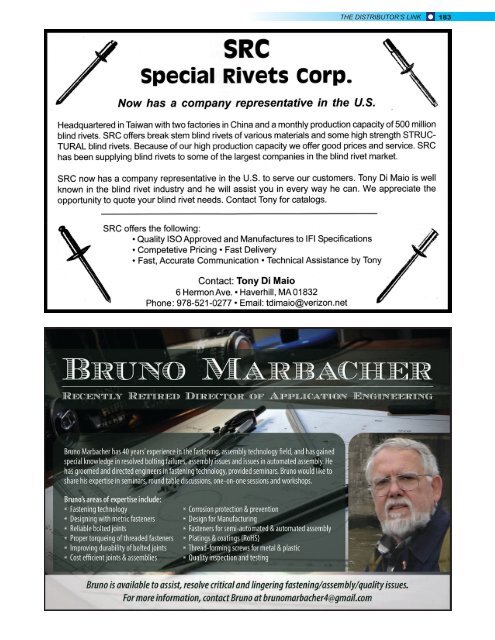SPRING 2022
Distributor's Link Magazine Spring 2022 / Vol 45 No 2 Distributor's Link Magazine Spring 2022 / Vol 45 No 2
THE DISTRIBUTOR’S LINK 183
184 THE DISTRIBUTOR’S LINK LAURENCE CLAUS HOT FORGING FASTENERS from page 180 is heated up in an induction coil and then introduced to the thread roller. Rolled threads are stronger and have an advantage in fatigue applications over cut threads. For this reason, some customers will dictate the process method for developing the threads. Threads FIGURE 8: PARTS COOLING AFTER FORMING Threads on large diameter, externally threaded fasteners may be cut or formed. Unlike smaller diameter parts which most often employ flat thread roll die technology, large diameter, externally threaded fasteners that have formed threads usually use large twin die cylindrical rollers. The unthreaded parts are positioned between two cylindrical roll dies rotating in opposing directions. The part is squeezed between these two dies as they rotate. This is a progressive process with each rotation forming a little more of the thread. With a cylindrical roller there are no limits to how many rotations the part can receive until the thread is finished. Threads can also be cut by drawing the cylindrical blank through a rotating set of cutters. This equipment feeds the part through the center of the cutting head so that it can generate very long threaded sections. Take, for example, long anchor rods. These products can be many feet in length with a six inch to one foot threaded section on one end. Cutting those threads using this process is easy. Parts that utilize hard to form materials may also need to add heat for thread rolling. The process is very similar to forming. The area to be threaded on the blank Typical Uses Warm and hot formed parts can find their way into many different products. However, they tend to be in products that use large diameter fasteners, very long fasteners or hard to form metals. Large diameter fasteners are often used in construction projects and on large industrial machinery. Very long fasteners, such as anchor rods, are used mostly in construction. Small and large diameter fasteners that utilize hard to form metals such as stainless steel, A286, Inconel, Hasteloy, and Titanium are commonly found in aerospace, defense, and harsh industrial applications. Summary Warm and hot forming are common fastener manufacturing processes when parts are very large or the materials they are made from are extremely difficult to form. Like smaller, cold formed fasteners, large diameter, hot headed fasteners must pass rigorous inspections and purchasing requirements. These components play an integral part of the fastener supply chain and serve in many critical applications. The manufacturing process, whether conducted on a high speed hot header or individually on a horizontal upsetter, the process is fascinating and well worth the time to understand and witness first-hand if given the opportunity. Acknowledgements The author wishes to extend his grateful appreciation to Atsushi Hashimoto of Unytite, Inc . and Rich Giusti of Haydon Bolt for sharing images 1 through 7 for this article. LAURENCE CLAUS
- Page 136 and 137: fastenerlinks THE DEFINITIVE WEB DI
- Page 138 and 139: fastenerlinks BRINGING YOU THE FAST
- Page 140 and 141: fastenerlinks BRINGING YOU THE FAST
- Page 142 and 143: 140 THE DISTRIBUTOR’S LINK JOE SA
- Page 144 and 145: 142 THE DISTRIBUTOR’S LINK NELSON
- Page 146 and 147: 144 THE DISTRIBUTOR’S LINK ROMAN
- Page 148 and 149: 146 THE DISTRIBUTOR’S LINK IFI SO
- Page 150 and 151: 148 THE DISTRIBUTOR’S LINK STAFDA
- Page 152 and 153: 150 THE DISTRIBUTOR’S LINK QUALIT
- Page 154 and 155: 152 THE DISTRIBUTOR’S LINK U.S. A
- Page 156 and 157: 154 THE DISTRIBUTOR’S LINK LAUREN
- Page 158 and 159: 156 THE DISTRIBUTOR’S LINK MID-AT
- Page 160 and 161: 158 THE DISTRIBUTOR’S LINK ROB La
- Page 162: 160 THE DISTRIBUTOR’S LINK CHRIS
- Page 165 and 166: THE DISTRIBUTOR’S LINK 163 MID-AT
- Page 168 and 169: 166 THE DISTRIBUTOR’S LINK ROBERT
- Page 170: 168 THE DISTRIBUTOR’S LINK COMPUT
- Page 173 and 174: NORTH COAST FASTENER ASSOCIATION 40
- Page 175: 172 THE DISTRIBUTOR’S LINK GUY AV
- Page 178 and 179: THE DISTRIBUTOR’S LINK 175
- Page 180 and 181: THE DISTRIBUTOR’S LINK 177 JOE SA
- Page 182 and 183: THE DISTRIBUTOR’S LINK 179 NATION
- Page 185: 182 THE DISTRIBUTOR’S LINK BRUNO
- Page 189: advertisers index # 3Q, INC. 79 Was
- Page 193: advertisers index I ICS FLANGE 41 S
THE DISTRIBUTOR’S LINK 183



